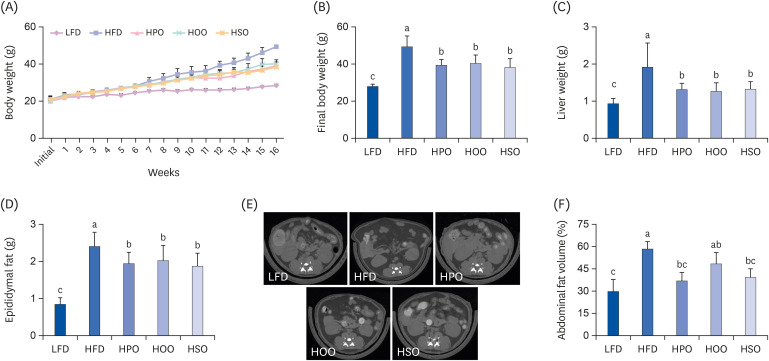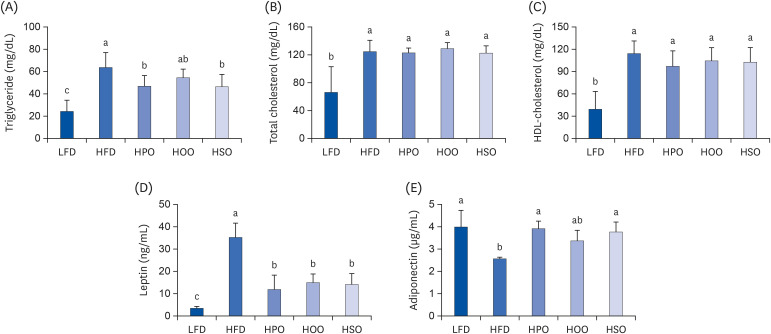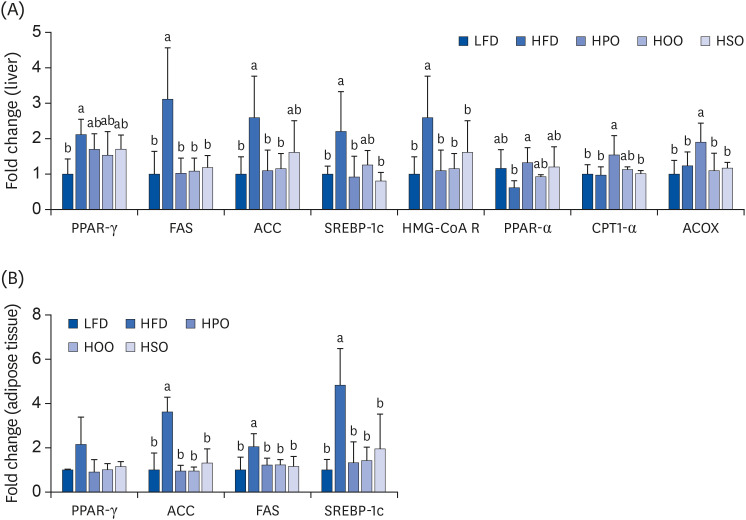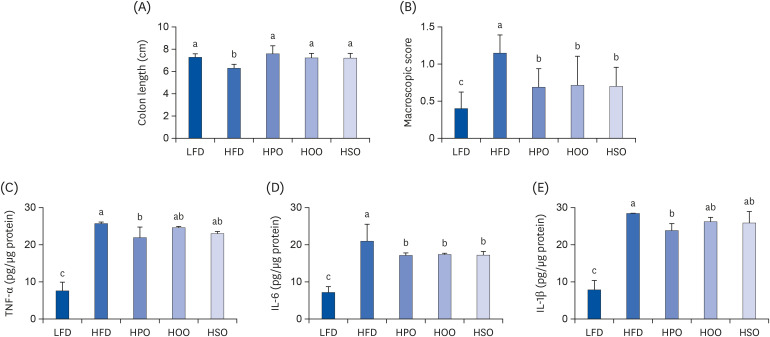Nutr Res Pract.
2020 Oct;14(5):425-437. 10.4162/nrp.2020.14.5.425.
Effect of vegetable oils with different fatty acid composition on high-fat dietinduced obesity and colon inflammation
- Affiliations
-
- 1Department of Food Science and Human Nutrition, Jeonbuk National University, Jeonju 54896, Korea
- 2Obesity Research Center, Jeonbuk National University, Jeonju 54896, Korea
- 3Department of Food and Nutrition, Chungnam National University, Daejeon 34134, Korea
- KMID: 2506881
- DOI: http://doi.org/10.4162/nrp.2020.14.5.425
Abstract
- BACKGROUND/OBJECTIVES
Different fatty acids exert different health benefits. This study investigated the potential protective effects of perilla, olive, and safflower oils on high-fat diet-induced obesity and colon inflammation.
MATERIALS/METHODS
Five-week old, C57BL/6J mice were assigned to 5 groups: low-fat diet (LFD), high-fat diet (HFD) and high-fat diet supplemented with-perilla oil (HPO), olive oil (HOO), and safflower oil (HSO). After 16 weeks of the experimental period, the mice were sacrificed, and blood and tissues were collected. The serum was analyzed for obesity- and inflammation-related biomarkers. Gene expression of the biomarkers in the liver, adipose tissue, and colon tissue was analyzed. Micro-computed tomography (CT) analysis was performed one week before sacrifice.
RESULTS
Treatment with all the three oils significantly improved obesity-induced increases in body weight, liver weight, and epididymal fat weight as well as serum triglyceride and leptin levels. Treatment with perilla oil (PO) and safflower oil (SO) increased adiponectin levels. The micro-CT analysis revealed that PO and SO reduced abdominal fat volume considerably. The mRNA expression of lipogenic genes was reduced in all the three oilsupplemented groups and PO upregulated lipid oxidation in the liver. Supplementation of oils improved macroscopic score, increased colon length, and decreased serum endotoxin and proinflammatory cytokine levels in the colon. The abundance of Bifidobacteria was increased and that of Enterobacteriaceae was reduced in the PO-supplemented group. All three oils reduced proinflammatory cytokine levels, as indicated by the mRNA expression. In addition, PO increased the expression of tight junction proteins.
CONCLUSIONS
Taken together, our data indicate that the three oils exert similar anti-obesity effects. Interestingly, compared with olive oil and SO, PO provides better protection against high-fat diet-induced colon inflammation, suggesting that PO consumption helps manage inflammation-related diseases and provides omega-3 fatty acids needed by the body.
Keyword
Figure
Cited by 1 articles
-
Green perilla leaf extract ameliorates long-term oxidative stress induced by a high-fat diet in aging mice
Olivet Chiamaka Edward, Shalom Sara Thomas, Kyung-Ok Cha, Hyun-Ah Jung, Anna Han, Youn-Soo Cha
Nutr Res Pract. 2022;16(5):549-564. doi: 10.4162/nrp.2022.16.5.549.
Reference
-
1. Kinlen D, Cody D, O'Shea D. Complications of obesity. QJM. 2018; 111:437–443. PMID: 29025162.
Article2. Jung UJ, Choi MS. Obesity and its metabolic complications: the role of adipokines and the relationship between obesity, inflammation, insulin resistance, dyslipidemia and nonalcoholic fatty liver disease. Int J Mol Sci. 2014; 15:6184–6223. PMID: 24733068.
Article3. Hruby A, Manson JE, Qi L, Malik VS, Rimm EB, Sun Q, Willett WC, Hu FB. Determinants and consequences of obesity. Am J Public Health. 2016; 106:1656–1662. PMID: 27459460.
Article4. Lumeng CN, Saltiel AR. Inflammatory links between obesity and metabolic disease. J Clin Invest. 2011; 121:2111–2117. PMID: 21633179.
Article5. Saltiel AR, Olefsky JM. Inflammatory mechanisms linking obesity and metabolic disease. J Clin Invest. 2017; 127:1–4. PMID: 28045402.
Article6. Yook JS, Kim KA, Kim M, Cha YS. Black adzuki bean (Vigna angularis) attenuates high-fat diet-induced colon inflammation in mice. J Med Food. 2017; 20:367–375. PMID: 28406732.
Article7. Orsavova J, Misurcova L, Ambrozova JV, Vicha R, Mlcek J. Fatty acids composition of vegetable oils and its contribution to dietary energy intake and dependence of cardiovascular mortality on dietary intake of fatty acids. Int J Mol Sci. 2015; 16:12871–12890. PMID: 26057750.
Article8. Lee AY, Choi JM, Lee MH, Lee J, Lee S, Cho EJ. Protective effects of perilla oil and alpha linolenic acid on SH-SY5Y neuronal cell death induced by hydrogen peroxide. Nutr Res Pract. 2018; 12:93–100. PMID: 29629025.
Article9. Schwingshackl L, Hoffmann G. Monounsaturated fatty acids, olive oil and health status: a systematic review and meta-analysis of cohort studies. Lipids Health Dis. 2014; 13:154. PMID: 25274026.
Article10. Hsu SC, Huang CJ. Reduced fat mass in rats fed a high oleic acid-rich safflower oil diet is associated with changes in expression of hepatic PPARα and adipose SREBP-1c-regulated genes. J Nutr. 2006; 136:1779–1785. PMID: 16772437.11. Hooper L, Martin N, Abdelhamid A, Davey Smith G. Reduction in saturated fat intake for cardiovascular disease. Cochrane Database Syst Rev. 2015; CD011737. PMID: 26068959.
Article12. Simopoulos AP. An Increase in the omega-6/omega-3 fatty acid ratio increases the risk for obesity. Nutrients. 2016; 8:128. PMID: 26950145.
Article13. Lee AY, Choi JM, Lee J, Lee MH, Lee S, Cho EJ. Effects of vegetable oils with different fatty acid compositions on cognition and memory ability in Aβ 25–35-induced Alzheimer's disease mouse model. J Med Food. 2016; 19:912–921. PMID: 27696934.14. Li Y, Hou MJ, Ma J, Tang ZH, Zhu HL, Ling WH. Dietary fatty acids regulate cholesterol induction of liver CYP7α1 expression and bile acid production. Lipids. 2005; 40:455–462. PMID: 16094854.
Article15. Bhurosy T, Jeewon R. Overweight and obesity epidemic in developing countries: a problem with diet, physical activity, or socioeconomic status? Sci World J. 2014; 2014:964236.
Article16. de Wit N, Derrien M, Bosch-Vermeulen H, Oosterink E, Keshtkar S, Duval C, de Vogel-van den Bosch J, Kleerebezem M, Müller M, van der Meer R. Saturated fat stimulates obesity and hepatic steatosis and affects gut microbiota composition by an enhanced overflow of dietary fat to the distal intestine. Am J Physiol Gastrointest Liver Physiol. 2012; 303:G589–99. PMID: 22700822.
Article17. Siri-Tarino PW, Chiu S, Bergeron N, Krauss RM. Saturated fats versus polyunsaturated fats versus carbohydrates for cardiovascular disease prevention and treatment. Annu Rev Nutr. 2015; 35:517–543. PMID: 26185980.
Article18. Ananthakrishnan AN, Khalili H, Konijeti GG, Higuchi LM, de Silva P, Fuchs CS, Willett WC, Richter JM, Chan AT. Long-term intake of dietary fat and risk of ulcerative colitis and Crohn's disease. Gut. 2014; 63:776–784. PMID: 23828881.
Article19. Tian Y, Wang H, Yuan F, Li N, Huang Q, He L, Wang L, Liu Z. Perilla oil has similar protective effects of fish oil on high-fat diet-induced nonalcoholic fatty liver disease and gut dysbiosis. BioMed Res Int. 2016; 2016:9462571. PMID: 27051672.
Article20. Chen T, Yuan F, Wang H, Tian Y, He L, Shao Y, Li N, Liu Z. Perilla oil supplementation ameliorates high-fat/high-cholesterol diet induced nonalcoholic fatty liver disease in rats via enhanced fecal cholesterol and bile acid excretion. BioMed Res Int. 2016; 2016:2384561. PMID: 27642591.
Article21. Wani FA, Albahrawy AZ, Rahiman S. Hypolipidemic activity of olive oil (Olea europaea) against high fat diet-induced nonalcoholic fatty liver disease (NAFLD) in mice. Open J Pathol. 2015; 5:720–726.
Article22. Thomas SS, Kim M, Lee SJ, Cha YS. Antiobesity effects of purple perilla (Perilla frutescens var. acuta) on adipocyte differentiation and mice fed a high-fat diet. J Food Sci. 2018; 83:2384–2393. PMID: 30070698.23. Kim SR, Je J, Jeong K, Kim SJ, Lee KY, Choi SG, Kim H, Park SW. Perilla oil decreases aortic and hepatic lipid accumulation by modulating lipogenesis and lipolysis in high-fat diet-fed mice. J Med Food. 2019; 22:14–21. PMID: 30207814.
Article24. Zhang T, Zhao S, Li W, Ma L, Ding M, Li R, Liu Y. High-fat diet from perilla oil induces insulin resistance despite lower serum lipids and increases hepatic fatty acid oxidation in rats. Lipids Health Dis. 2014; 13:15. PMID: 24422660.
Article25. Kim KA, Gu W, Lee IA, Joh EH, Kim DH. High fat diet-induced gut microbiota exacerbates inflammation and obesity in mice via the TLR4 signaling pathway. PLoS One. 2012; 7:e47713. PMID: 23091640.
Article26. Lee JC, Lee HY, Kim TK, Kim MS, Park YM, Kim J, Park K, Kweon MN, Kim SH, Bae JW, Hur KY, Lee MS. Obesogenic diet-induced gut barrier dysfunction and pathobiont expansion aggravate experimental colitis. PLoS One. 2017; 12:e0187515. PMID: 29107964.
Article27. Lim SM, Kim DH. Bifidobacterium adolescentis IM38 ameliorates high-fat diet-induced colitis in mice by inhibiting NF-κB activation and lipopolysaccharide production by gut microbiota. Nutr Res. 2017; 41:86–96. PMID: 28479226.28. de La Serre CB, Ellis CL, Lee J, Hartman AL, Rutledge JC, Raybould HE. Propensity to high-fat diet-induced obesity in rats is associated with changes in the gut microbiota and gut inflammation. Am J Physiol Gastrointest Liver Physiol. 2010; 299:G440–8. PMID: 20508158.
Article29. Hassan A, Ibrahim A, Mbodji K, Coëffier M, Ziegler F, Bounoure F, Chardigny JM, Skiba M, Savoye G, Déchelotte P, Marion-Letellier R. An α-linolenic acid-rich formula reduces oxidative stress and inflammation by regulating NF-κB in rats with TNBS-induced colitis. J Nutr. 2010; 140:1714–1721. PMID: 20724486.
Article30. Bigagli E, Toti S, Lodovici M, Giovannelli L, Cinci L, D’Ambrosio M, Luceri C. Dietary extra-virgin olive oil polyphenols do not attenuate colon inflammation in transgenic HLAB-27 rats but exert hypocholesterolemic effects through the modulation of HMGCR and PPAR-α gene expression in the liver. Lifestyle Genom. 2018; 11:99–108. PMID: 30630166.
Article31. Liao FH, Liou TH, Chiu WC, Shieh MJ, Chien YW. Differential effects of high MUFA with high or low P/S ratio (polyunsaturated to saturated fatty acids) on improving hepatic lipolytic enzymes and mediating PPARγ related with lipoprotein lipase and hormone-sensitive lipase of white adipose tissue in diet-induced obese hamster. Int J Obes. 2010; 34:1608–1617.
Article32. Liao FH, Liou TH, Shieh MJ, Chien YW. Effects of different ratios of monounsaturated and polyunsaturated fatty acids to saturated fatty acids on regulating body fat deposition in hamsters. Nutrition. 2010; 26:811–817. PMID: 20022469.
Article33. Li Y, Hruby A, Bernstein AM, Ley SH, Wang DD, Chiuve SE, Sampson L, Rexrode KM, Rimm EB, Willett WC, Hu FB. Saturated fats compared with unsaturated fats and sources of carbohydrates in relation to risk of coronary heart disease: a prospective cohort study. J Am Coll Cardiol. 2015; 66:1538–1548. PMID: 26429077.
- Full Text Links
- Actions
-
Cited
- CITED
-
- Close
- Share
- Similar articles
-
- Effects of Omega-3 Fatty Acid during Pregnancy
- Effects of perilla oil on plasma concentrations of cardioprotective (n-3) fatty acids and lipid profiles in mice
- Regulating Hypothalamus Gene Expression in Food Intake: Dietary Composition or Calorie Density?
- Chemopreventive and Chemotherapeutic Effects of Fish Oil derived Omega-3 Polyunsaturated Fatty Acids on Colon Carcinogenesis
- A Study on the Fat and Fatty Acid Intake of College Women Evaluated through Internet Nutritional Assessment System







